Review: LCD Projector Mitsubishi HC-5000
The worlds first Full-HD D6/C2fine Home Cinema projector
We know that many of our readers have been looking forward to reading our review of the first Full-HD LCD Home Cinema projector, the Mitsubishi HC5000. We ourselves have also been impatient, but have made a conscious decision to wait for the finished machine this time. And now the time has come at last, and we are able to present an elaborate review of the finished production model.

With an MSRP of € 3990,-- the HC5000 is the cheapest way to get in to the world of Full-HD. Of course, this begs the question how much quality and what kind of image such a price offers. This question will be addressed in this review...
We refer in advance to our test criteria, which are described in detail in our Know How Special: "Projectors / Plasma TV's - Quality aspects".
1. Equipment and Technology (Know How Link here)
The design of the HC5000 has been known for some time. The sleek form with the magnetic dust shield cap takes a little getting used to for many tastes, but can be integrated well in most rooms.

This is also apparent in choice of a bright color, which fits the color of most ceilings. In the finished series the HC5000 now exhibits a visible pearl effect, which makes the machine appear very noble. Unfortunately this pearl effect is hard to capture on photo.

When not used the optics can be protected against dust with a cap
The build quality altogether is very stable and of high-quality, as we are already used to from Mitsubishi projectors. The compact design also clearly underlines this impression.
1.1 Technology (Know How Link here)
The technical structure is particularly interesting, almost exciting with the first Full-HD Home Cinema LCD projector. Even if there are only two finished production models in Germany at present, we took the risk and opened the machine up to give you a detailed view of the inside.

After removing the white cover a large shielding plate appears, which is also typical for a Mitsubishi projector. Thus "interference" should not be able to develop with other electrical appliances. Under the shield we found the also surprisingly large motherboard.

Complete control electronics of the HC5000
The more interesting construction parts however are all on the hidden lower surface, which gave us a good reason to remove the motherboard.

The top side of the motherboard...
... and the more interesting bottom side:

As is already known, the HC5000 employs the "HQV" signal processing, which is talked about a lot lately particularly in High ending DVD Players.

In the HC5000 a HQV Reon heart beats.
And the mandatory Pixelworks:

To what extent the HQV makes itself useful in the new Mitsubishi projector, we will examine in detail in the picture test. So far the electronics are concerned, further of interest is the optical structure of the projectors. It actually concerns the first machine with Epson's new C2Fine/D6 LCD generation. Three of these LCD panels (one for each basic color) are firmly installed to the prism block, which makes a common color image from the three basic colors again.

In the picture above the LCD control cable and the prism block can be recognized. If you look closely, the control component which is now integrated in the cable can also be seen, serving to further reduce LCD artifacts.

Full-HD LCD in full splendor

LCD projectors are well-known for a certain dust susceptibility, so some models clearly showed weaknesses here. A residual risk actually always exists that a dust grain sets on one of the three LCD panels and provides a disturbing color mark within dark ranges. Here Mitsubishi engineers took precautions: both the optical block and the entire airway were encased specially for dust-protection.

The light engine, outside and inside the projector
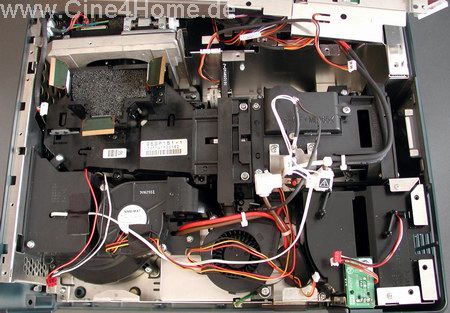
In addition, the external air cleaner provides for dust shielding, it is positioned laterally at the machine and can be taken out at any time without trouble, even when the machine is installed with a ceiling mount.
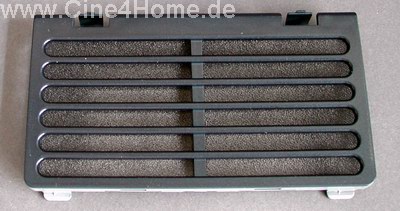
The lateral flap with integrated
foam filter
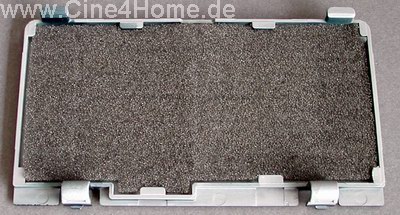
The ventilation should not only be particularly dust free, with manufacturer data of only 19dB (!!) the HC5000 also with some distance one of the quietest home cinema projectors built to date. And indeed, we hardly believed our ears when we took the projector in operation. The machine is so quiet that one even hardly notices it from small distances in quiet rooms. Every DVD player is a noise generator in comparison.

In the machine numerous special ventilators, which are
perfectly tuned with regard to in size, number of revolutions and placement
With the HC5000, the noise problem is eradicated once and for all from the world, it is simply inaudible in normal movie viewing! And also in the high lamp mode the projector remains so quiet that it still belongs to the quietest in its class. For all noise-sensitive home cinema fans the HC5000 is a "must have".
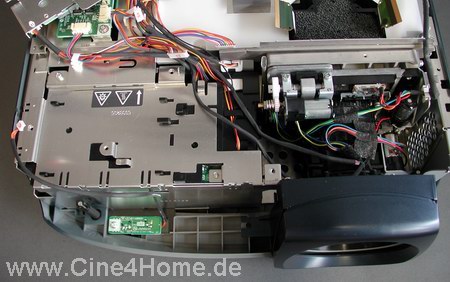
The main power supply is in front next to the optics
The quiet ventilation was not achieved at the expense of the lamp performance. Here the for projectors usual 160 Watts UHP lamp is used. It should be usable for about 5000 hrs in the Eco mode, making it a true economic miracle.

High life expectancy and therefore low cost: the light source
The lamp pit (i.e. beginning of the optical path) is likewise practically located at the side of the projector, so that the lamp can be exchanged quite simply if necessary.
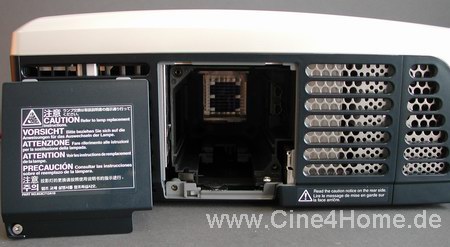
The lateral lamp pit with first integrator lens
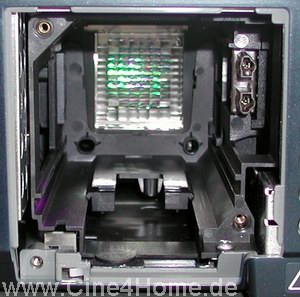
Altogether, the technical structure of the HC5000 is more than convincing. The newest technology is used (D6 + HQV), the optical structure is compactly and at the same time dust-protected, while also being almost inaudibly ventilated. The build quality is always on highest level, more can one not expect.
1.2 Connections / Signal types (Know How Link here)
Also regarding connections there is a constant rise of requirements. Particularly the introduction of digital signals increasingly necessitate the increasing number of the appropriate inputs. Mitsubishi obviously had the exact same idea and added one of each kind: 1x HDMI and 1x DVI.
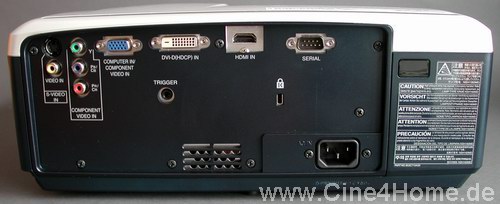
In addition 1x RGB H/V (SubD), 1x YUV, 1x S-Video (Hosiden) and 1x Composite (Cinch) as well as a serial connection for device control and/or updates and a trigger exit for screen control are present.
Regarding signal types: all new standards and resolutions are supported of course. This also includes 1920x1080p meanwhile and, particularly pleasing with regard to HD-DVD and Bluray, also 1080/24p. Thus it will finally be possible to enjoy films in their original speed in this country.
1.3 Setup (Know How Link here)
The biggest advantage of LCD projectors is that they are substantially more flexible as projectors using other techniques. These advantages should be maintained with Full-HD resolution. Like many home cinema projectors the HC5000 also possesses a horizontal and a vertical Lens Shift. In order to offer even more luxury in this price range, Lens Shift as well as Zoom and Focus are electrically adjustable by remote control.

A number of small engines "directs" the optics of the projector
The control is more than exemplary here: first, only small steps are implemented, so that a fine adjustment is simply possible. Only if one presses the keys longer, the mechanics work faster. Thus the electrical operation becomes really practical and not as inaccurate, as with many other models.
The vertical Lens Shift is very generous as typical for LCD (75%), so that the projector can be adjusted to almost any space & screen height. Horizontal the adjustment range is smaller, only about 5% is possible. The reason for this difference in relation to conventional LCD models should be the high requirement for sharpness at Full-HD resolution.
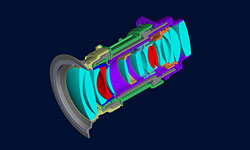
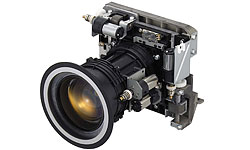
The optics consist of over a dozen full glass elements
In addition a completely new optical engine was designed with high-quality glass optics. A too large horizontal Lens Shift would have meant an unavoidable loss of sharpness, at least this was the justification we were given.

The optics from the front
Despite the reduced horizontal Lens SHIFT the flexibility of the projector is above average, which should not place the user before unsolvable placement problems.
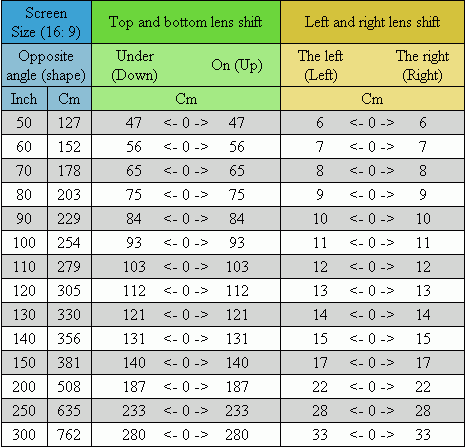
Lens Shift range of the HC5000
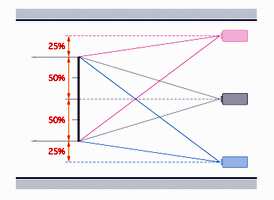
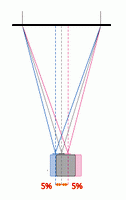
The Zoom range of the projector is exemplary large. Both in large and small
rooms most diverse dimensions of picture size can be reached.
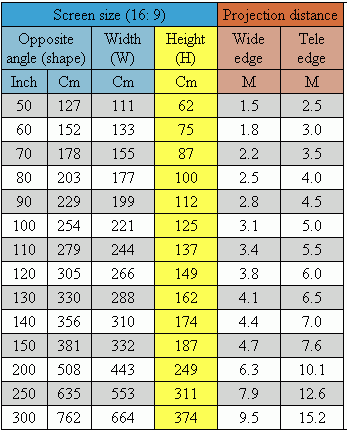
Spacer table Mitsubishi HC5000
With placement the HC5000 can out-play the strengths of the LCD technology. It exhibits a large Lens Shift and a large Zoom range, like almost no DLP projector, especially in this price range. In addition, it offers the luxury of the practical and at the same time well working motorized optic control. All in all a very solid achievement, which is offered here.
2. Operating the projector (Know How Link here)
During the operation of the HC5000 we met a good old concept again, that of the DLP brothers HC3100/3000. Most functions and also the layout were almost invariably taken over. Only a few additions are to be discovered.
2.1 Remote Control
New any way is the remote control. It is not too small, lies well in the hand and offers numerous functions. For darkened rooms it is electrically illuminable if necessary.
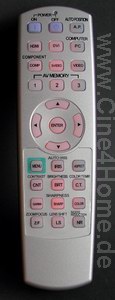
Particularly the direct input selection and format keys as well as the generous tax cross are positively noticed. The range of the infrared transmitter is sufficient here, but now and then the projector does not react with absolute reliability. Sometimes it is necessary to point the remote control directly towards the projector.
Also on the equipment top side all substantial function keys are elegantly placed, the HC5000 can thus be operated without remote control in this way.
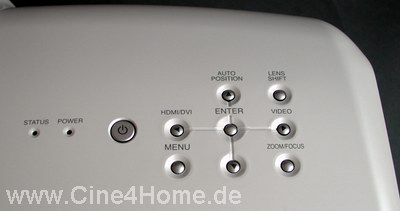
Keys on the HC5000 top side
2.2 Menus
The menu concept, as previously mentioned, was copied from the Mitsubishi DLP brothers HC3000/3100. All functions are distributed over four main categories:
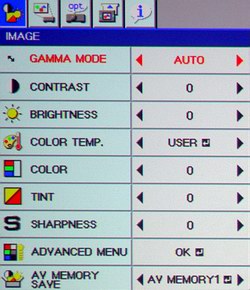
The first category "Image" contains, like the name already says, all substantial parameters to the picture adjustment. Contrast, Brightness as well as the Gamma distribution and White Alignment can be adjusted here. The Gamma function was improved upon. The Brightness distribution now cannot only be adjusted separately in three sections, but also the three basic colors are now separately adjustable.
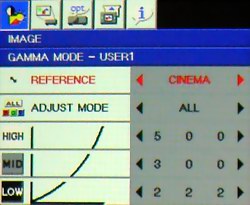
Each column corresponds to a color (R, G, B), which then makes nine different parameters. Not only the Gamma, but also the Color adjustment can be further perfected this way. This is an outstanding idea, which has not been implemented with any other projector so far.
We continue with the second column, "Installation": here can be chosen between the super-quiet Eco mode and the quiet Normal mode of the lamp, as well as other placement-dependent parameters.
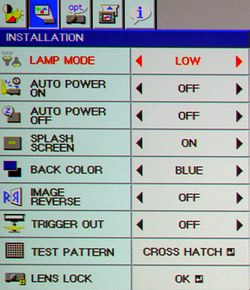
The third category covers different "Feature"-functions, of which at least the Display format as well as Black Level ("Setup") have a direct influence on the picture.

"Cinema mode" describes the function of the De-Interlacer with incoming half-image signals, it can be switched between "Off" and "Auto". More to this in the course of our picture test.
Finally, the fourth and last column "Signal" covers all remaining functions, including picture parameters like "Overscan", Blanking or Image Position.
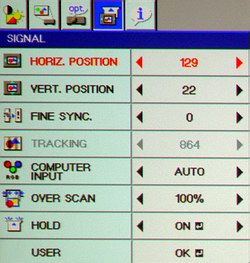
That concludes the adjustment categories, but there is also the "Info." category, which supplies substantial information about the incoming picture signal as well as the already "used" lamp running time .

The control concept was noticed already with the predecessors HC3000 and HC3100, and rated very positively. Thus it should come as no surprise that it was transferred to the HC5000 to a large extent. Pleasing is the fact that the adjustment possibilities have been further refined, especially with regard to the gamma range adjustment. In interaction with the practical remote control this results in an efficient control concept, which can be learned quickly and intuitively.
3. Image test
Now finally to the detailed picture test, to which we already received many inquiries in the last weeks. What is the newest LCD technology capable of with regard to image quality?
3.1 Screendoor / Pixel structure (Know How Link here)
We immediately begin with one of the most explosive questions of the LCD technology, the Screendoor effect. Film fans with high visual acuity have often complained about the Screendoor. It is exciting now to see how the HC5000 fares, since this concerns the first Full-HD projector with the new Epson D6 C2Fine technology. Does the increased number of pixels, now doubled compared to 720p (and now at over 2 million), help?
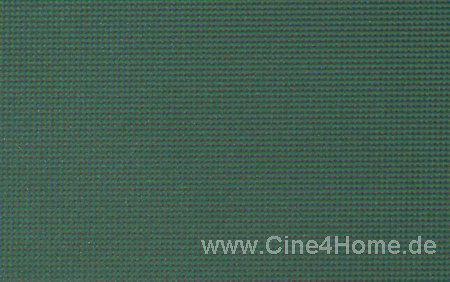
As the screen shot above shows, the problem of the pixel structure is clearly reduced with the full HD resolution. Even from small viewing distances the Screendoor is by far no longer as noticeable as with the 720p LCD projectors. The fill rate in the equation did not change, but the distances of the pixels to each other are so small that one can hardly still notice them. One of the most discussed artifacts of LCD projectors is to be regarded as almost solved.
3.2 Color Space (Know How Link here)
Due to the increasing requirements projectors are becoming more perfect out of the box. But in one domain, the color space, not rarely deviations from the standard can clearly be seen. All colors on the screen are achieved by mixing the three basic colors Red, Green and Blue, but there are innumerable tones of Red, Green and Blue. The video standard exactly specifies the basic colors.

Above diagram shows the color space of the HC5000 (white triangle) in relation to the HDTV standard (dark triangle). As one can see, the basic colors Blue and Red are aligned very well and almost exactly meet their their optimal value. A larger deviation is to be recognized in Green, which appears a little over-saturated on the screen. So some natural tones can appear a little too strong, however within a tolerable framework.
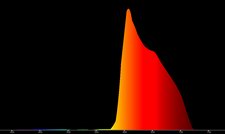
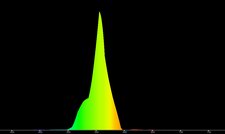
Spectral analysis of the individual basic colors
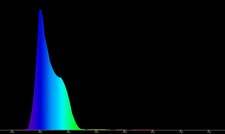

The tuning of the secondary colors is outstanding: Cyanide and Magenta are aligned exactly to the point where they should be. Only Yellow is a little bit outside of the standard due to the increased color space. Altogether the result, particularly for an out-of-the-box LCD projector, is to be regarded as very good, however further tuning of the color space is not possible.
3.3 Color Temperature (Know How Link here)
The HC5000 is not an entry-level projector, but a projector of the elevated class. Therefore we apply elevated requirements regarding color and brightness uniformity. The picture menu of the projector offers three different tuning setting from the factory: Deeply, Middle and High.
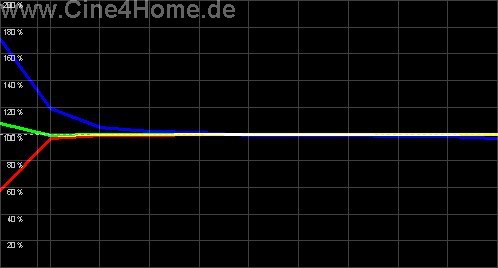
Factory setting: Middle
Above diagram does not show the result of a later accomplished calibration, but is an "Out Of The Box" measurement of the factory setting "Middle". : Again numerous experts will have thoughts on how few deviations are to be expected with a digital picture chain with good factory settings. Both projector and brand DVD Player (in this case a Pioneer) are "neutral" anyway.
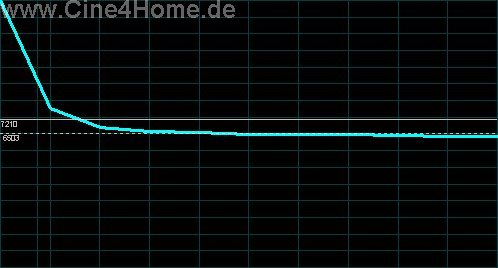
Point-exact D65 adjustment
Better a factory tuning can hardly be, our complements go to conscientious measuring and adjustment from the factory. The color representation on the screen is absolutely natural and does not work artificially too multicolored. Color adjustments intended by the director also appear exactly as they should.
Factory setting "Low" supplies, like the name already says, a clearly warmer image output. With a increased Red level and a reduced Blue the image representation is slightly yellowish.
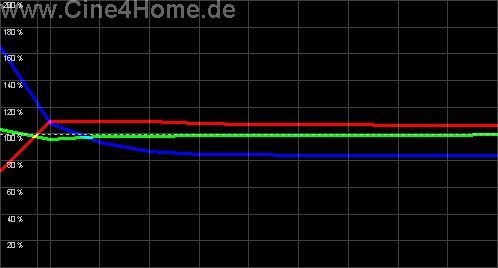
Factory setting: Low
This tuning can be useful for certain photography representations, for the DVD rendition it however is not recommended.
The factory setting "High" remains, and here also the name is according the result, the tuning of the picture shows an excess of Blue and is very cool in this mode.
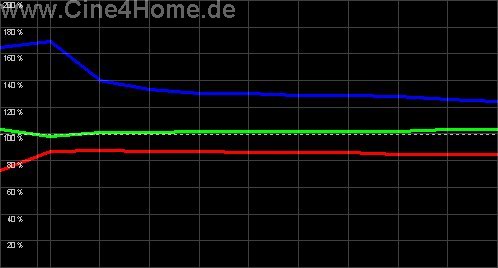
Factory setting: High
So far the factory settings, however there is still the mode "Hi-Bright". With this setting the projector supplies an uncorrected lamp spectrum, which leads to a increased luminous efficiency on the screen.
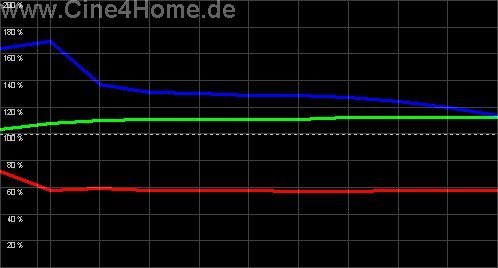
Hi-Bright-mode
As one can see, the light output however is more important than color accuracy. With 50% too low on Red and 20% too much Blue the image representation is much too cool, for the movie representation this mode is therefore not recommended. For the occasional television viewing without darkening the room or presentations this mode is quite usable however.
By the way: for those who want to manually adjust the color temperature, an extensive RGB menu is available.
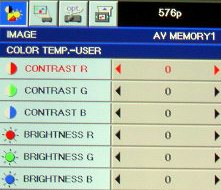
There was no need for further adjustment with our review sample, but it is always good to have such adjustment possibilities at hand as one can never tell what happens with colors over time.
3.5 Luminance tracking / uniformity (Know How Link here)
In the last two chapters the HC5000 projector more than convinced us with its very good to outstanding results using its factory settings. Therefore we expected equally good results during the brightness distribution. The Gamma menu again makes three factory settings available: Cinema, Sport and Video.
The name "Cinema" suggests the best results, therefore we begin here with our measurements. We are not disappointed, the result are exactly on the target with 2.21, which is according to the current standard of film mastering.

Factory setting: Cinema
That the gamma curve is not only on its standard target, it runs also absolutely evenly without "dents and bumps". Thus the picture appears deep in such a way on the screen like it is, without oversaturated distortions or "drowning" of dark picture contents.
The next Preset which can be examined is "Video". We would expect a Gamma curve also here around 2,2, but the result is visibly "flatter" with 2.1.
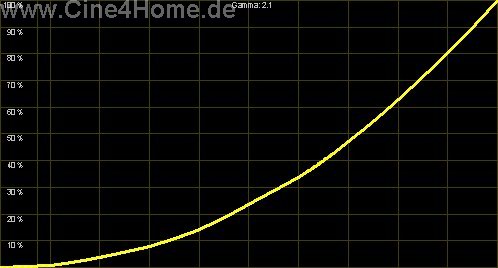
Factory setting: Video
This Preset is suitable for not completely darkened rooms, however we recommend "Cinema" preset which ensures a more deep picture.
The third Preset "Sport" is self-describing, meant for the representation of sport transmissions under non-optimal conditions. The gamma distribution is mostly shifted strongly into bright of ranges here, so that all details remain on the screen.

Factory setting: 2.01
As expected the gamma curve here is still flatter, with approximately 2.0 the picture is clearly brighter. Without an exaggerated rise with blooming (reverse curve) however one did, which comes the naturalness of the picture much to property.
With three factory settings, the user can select between a Gamma curve of 2.0, 2,1 and 2,2. However curves larger than 2,2 (between 2,3 and 2,4) were neglected, and especially these can produce an even greater image depth in perfectly black rooms. Here the user must intervene, for the Gamma Equalizer already mentioned under "Operation" can offer good results here.

Steeper and at the same time absolutely homogeneous gamma curves can be created this way, one does not even have to be a "calibration genius". Only high-quality measurement material for the determination of the brightness curve is advisable.
Altogether factory settings ensure a very good utilization of the contrast range, which adequately reproduces the picture in its brightness composition. Dark details are displayed cleanly and with great nuance, and the same applies to bright ranges. The picture is atmospheric and spatially deep.
3.4 Black level, Contrast, Brightness (Know How Link here)
Now we come to the most marketing effective aspect of the projection, the contrast. In the last couple of months LCD projectors have strongly caught up in this area by utilizing the adaptive iris procedure. The catch here: often the iris is programmed too "agressively", causing disturbing picture flickering, especially in dark scenes.
The HC5000 also uses such a adaptive iris, which of course we examined in every detail under the magnifying glass. It is placed at the beginning of the optical path, directly behind the first integrator lens.
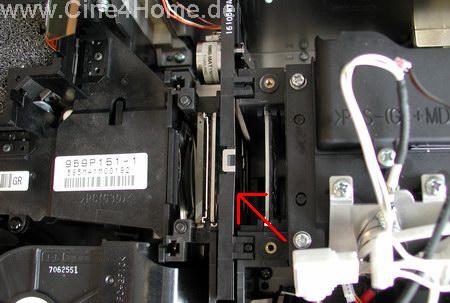
The adaptive iris from above in the optical path
Of course we removed the iris, in order to be able to make a more exact technical picture of it.
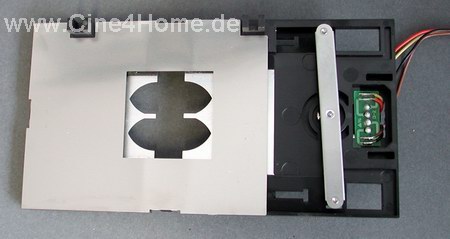
The technical structure strongly reminds us of the Sanyo Z4 variant: A small electric motor moves two sheet metals, which are movable like sliding doors against each other over a lever.
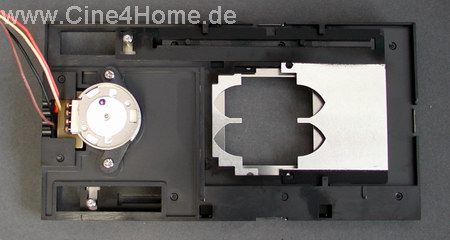
From the back the small motor is visible
Above pictures show the iris in the opened condition. The 8-shape is interesting. In the closed condition this results in two light holes.
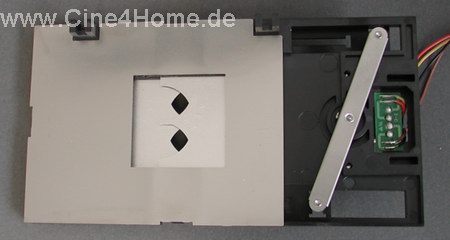
Completely closed iris
This technology works almost without sound and the quantity of light can well be
proportioned. Disadvantage of this method however is a certain inertia, the iris
can not be adjusted in "real time" (50 or 60 times per second). An inconspicuous programming is indispensable here. We examined the iris to the bone with a difficult film scene. We noticed that overall its function is within a good inconspicuous range. It regulates the light in such a way that dark scenes appear reliably dark, and outdoor recordings are realistically bright. With fast transitions and/or camera cuts of bright on dark however, sometimes a slight darkening and/or lightening is perceptible. So the iris does not operate perfectly. But the advantages outweigh, so that their use is quite recommendable. For those who find thus disturbing, the adaptive iris can simply by switched off by pressing a key on the remote control. In this case however no adaptive iris is in the optical path anymore.
Now we come to the much desired measurement results concerning contrast and light output. Due to the number of combinations we provide these in a table:
Measured Contrast and Light output
Mitsubishi HC5000
Color temperature/mode |
Adaptive screen |
Lumen Eco-mode |
Lumen Hi-mode |
Contrast |
D65/Middle |
Auto1 |
440 |
600 |
3200:1 |
D65/Middle |
Auto2 |
440 |
600 |
5800:1 |
D65/Middle |
Auto3 |
440 |
600 |
4000:1 |
D65/Middle |
Off |
440 |
600 |
720:1 |
Hi-Bright |
Auto1 |
800 |
1100 |
5600:1 |
Hi-Bright |
Auto2 |
800 |
1100 |
10300:1 |
Hi-Bright |
Auto3 |
800 |
1100 |
7100:1 |
Hi-Bright |
Off |
800 |
1100 |
1300:1 |
The table makes clear that the adaptive iris always opens the same amount and the contrast is affected only by the maximum locking degree. With up to 600 lumens during correct color representation the HC5000 clearly belongs to the brighter projectors, which can also project display widths of over 3 meters without a problem. The presentation at the IFA this year was a very good example. And should the need for more light reserves arise occasionally (for example watching TV in low light conditions), then the projector offers up to 1100 lumens of light reserves. However in that case one should not have any requirements with regard to color perfection anymore. In addition, good contrast ratios are achieved by the adaptive iris. Depending upon mode the iris works more or less aggressive, which also has an effect on the inconspicuousness of adaptive iris operation in certain scenes. To the contrast values with switched off iris, it must be said that the projector operates without any iris whatsoever, neither in the optical path nor in the optics. Also, there is no iris in the optics, which means that it is difficult to technically compare the measured value other devices. With an iris in the optics, an increased native contrast could be reached. Therefore is it unfortunate that no manual iris was integrated into the optics, as with for instance a Sanyo PLV-Z5 or Hitachi PJ-TX300. There the system with dual irises more than paid for itself.
All in all, the contrast behavior of the HC5000 can be evaluated with good. It achieves a good Black Level while at the same time achieving very good maximum brightness. The system of the adaptive iris is efficient here if not perfect in detail. Instead, very much flexibility is offered. A "Iris Closed" option would have been desirable (perhaps by firmware updates?), as well as an iris in the optics for scattered light optimization. The picture of the HC5000 however is very pleasing because of its picture depth, which more than adequately reproduces the original Film look. Still the DLP technology is however undisputed winner with regard to picture depth, at least in optimized home cinema rooms.
3.6 Sharpness / Brightness uniformity / convergence (Know How Link here)
Much attention was given on the used optics with the HC5000. The elaborate construction of single lenses is to ensure a continuous sharpness over the entire picture, while at the same time appropriately using the full-HD resolution of 2 megapixels.
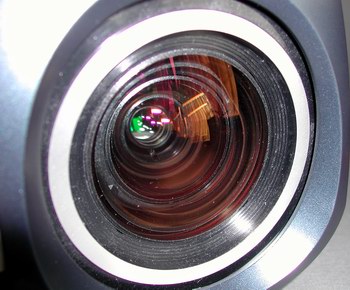
The optics also fulfill these requirements in convincing way: During our test viewing we could not see a visible loss of sharpness, not even towards the corners. The optics are able to appropriately project the full HDTV resolution on the screen. With regard to illumination, no disturbing wastes are to be seen towards the edges. The picture seems evenly illuminated also with computer projections.
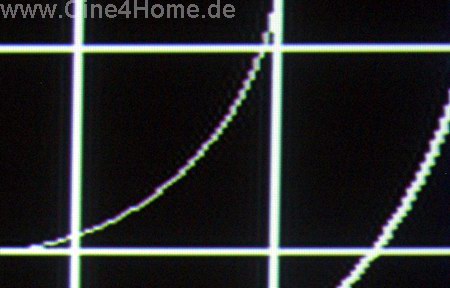
A good average is offered with the convergence. With our test equipment the picture showed only minimal blue seams, which are not noticeable however from the viewing distance. Here the projector does not have to hide itself for the competition. "Perfect convergence" is a utopian idea with a 3 Chip projector of this resolution. We can not judge however to what extent there is a certain series dispersion here, after reviewing one machine.
3.7 Overscan (Know How Link here)
Almost all manufacturers have learned it in the meantime: Cut off picture edges disturb the picture composition, particularly with features. The fundamental perfect solution is several stages of variable Overscan and/or a Blanking option. Since the HC3000 Mitsubishi has realized maximum flexibility with their Home Cinema projectors.

The Overscan is adjustable from "Off" (above),
to "Large" (below).
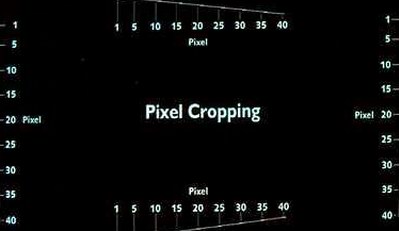
Additionally, with the aid of the "Shutter"-function, Blanking can be individually provided to every picture edge. This function is particularly practical, if supplementary disturbing signals emerge over or under the picture (e.g. videotex). Such disturbances can be elegantly eliminated even without Overscan. There is no better and more versatile option.
3.8 De-Interlacing (Know How Link here)
One of the well-known characteristics of the HC5000 signal processing is the HQV processing of Silicon Optix. According to the manufacturer, this should offer some options:

- MAVP (Motion Adaptive Video Processing) / FOUR-FIELD PER-PIXEL SD/HD DEINTERLACING
- SD/HD FILM CADENCE PROCESSING FOR 3:2 AND 2:2 CADENCES
- SD/HD MULTI-DIRECTION DIAGONAL FILTER (MDDF)
- SD/HD DETAIL ENHANCEMENT
- COLOR SPECTRUM CONTROL
- FULL 10-bit 4:4:4 SCALING
As is the case with every test we fed the projector video material and film material. The results are very different:
Video material
Video material, like television shows, sport transmissions or your own video
recordings, are recorded with 50 different pictures per second. Although each
Half-image offers only the half resolution here, it represents its own snapshot.
With this video material the HC5000 offers good results throughout. While
standing picture elements from two sequential half-images are joined after the
so-called "Motion Adaptive" procedure, moving elements are "extrapolated" by the internal scaling electronics, just as the data above promised. The procedure was converted well. Video pictures (e.g. of a satellite receiver) are converted with very good sharpness without movement artifacts or fraying to the progressive representation. For watching television the projector is therefore outstandingly suitable, we were impressed with the image quality.
Film material
Unfortunately, these outstanding results did not repeat themselves during the half-image feeding of film material: with film material, each cinema picture is divided into two half-images and transferred, which afterwards must be adequately merged by the de-Interlacer. With our PAL standard the film is accelerated from 24 into 25 pictures/sec. and the 25 frames are changed into 50 half-images. Task of the HQV would now be to merge those 25 original pictures together again. HQV signal processing exhibits such PAL Film mode, but stability leaves much to be desired. With the usual test film scenes the projector falls out of film mode again and again in very short distances, which immediately leads to picture unrest and loss of sharpness. Here we clearly expected more, particularly since a Denon 2930 DVD player with the same chip set obtains clearly better results.
For watching TV the de-interlacing characteristics of the HC5000 are outstandingly suitable . The television picture is astonishingly sharp in detail. With Film material its a different story. Here should one should fall back to a good DVD player with Progressive Scan to get the best quality.
3.9 Details / Scaling / Sharpness (Know How Link here)
Now we arrive at the second domain of the chip set, signal processing. Like always we will examine sharpness and scaling accuracy.
3.9.1 Signal processing
Analog / Digital
Contrast transitions, which are displayed sharply and without disturbing double outlines, are exemplary. Even with Sharpness, from factory nearly set to maximum, hardly any disturbing artifacts are visible.
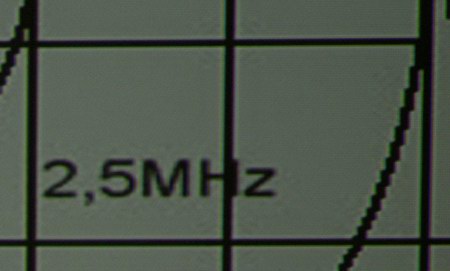
Minimal double outlines with Analog feeds

Almost no double outlines with digital feeds
Particularly good are the results with digital feeds. Here no disturbing double outlines were to be seen.
3.9.2 Horizontal Scaling
The DVD resolution of 720 x 576 pixels is clearly beneath the native dissolution of the projector (1920 x 1080). Therefore it must be converted by the internal scaling electronics:
Analog / Digital
The horizontal scaling characteristics of the HC5000 are on a very good level. The Burst test signal is displayed on the screen almost without linearity fluctuations.

Even the difficult resolution range around 6MHz hardly points out interference in the scaling. An also positive observation is the only very slight drop in level, even small details appear almost just as bright as big details. Thus the sharpness of the picture is visibly enhanced.

The color resolution is looking equally good. The good scaling provides an appropriate resolution adjustment without disturbing artifacts. The color separation is ensured up to highest resolution, could however be more precise in some parts.
3.9.3 Vertical scaling
Analog / Digital
Vertical scaling looks even better. Especially here Full-HD projectors take advantage of their clearly increased resolution of 1080 lines, almost double that of our PAL standard.

As artifact-free as this the above test pattern has only rarely showed up on our screen so far. Linearity fluctuations are on an imperceptible level, especially vertical camera movements in film and television clearly take advantage of this.
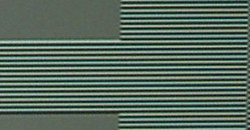
Even single-lined details (picture above) are displayed on the screen without artifacts. Here no 720p projector, and even some native PAL projectors, can keep up.
So far test patterns, but how does the HC5000 fare with moving pictures? As the preliminary results suggest, very well: the image replication exhibits an absolutely exemplary image definition, which at the same time however does not appear artificially digital. We had a similar "Aha"-effect a while ago with the Denon High-End DVD Player, which also used the HQV Technology for the first time. Without a doubt the scaling characteristics of the HC5000 are good enough for an external Scaler for picture improvement to become redundant. The picture appears natural in detail, PAL material is prepared favorable, and all of this without disturbing side effects or artifacts. Even in this elevated price range one does not frequently find such signal processing in video projectors.
Notes:
With pictorial material in the 4:3 "television format" a part of the horizontal resolution remains unused. As is the case for a conventional 16:9 television, black bars appear on the left and on the right of the picture. The "remaining" resolution however still clearly lies above our PAL standard, so even with 4:3 material there is no deficit in the detail representation.
3.10 Shading / Color uniformity (Know How Link here)
An uneven color temperature in the picture is not a LCD typical characteristic, but one each 3-Chip projector has to fight. Fortunately the manufacturers developed digital balance possibilities in the meantime, so that this can be fought.
Our test equipment (normal series) exhibited a continuous color distribution, disturbing Shading was not apparent. In uniform grey surfaces one could recognize a slight shift in red to the right boundary regions, however these were so subtle that these were invisible in the film picture. If this standard is maintained with all devices, then no problems are to be expected here.
3.11 Vertical Banding
Finally we take a look at a much discussed LCD artifact, Vertical Banding (VB). But we can make it short: the new, inorganically developed D6-panels from Epson with their shorter control lines do not exhibit Vertically Banding. Even in homogeneous grey surfaces no VB was to be seen. In other words: The HC5000 does not exhibit Vertical Banding.
3.12 HDTV / Image Evaluation
Those who read the test completely and did not jump directly to our conclusion will have already noticed: the Mitsubishi HC5000 is exemplary in most of our test disciplines. This is also apparent if movies are viewed with it:
The color representation is tuned from the factory to be absolutely natural and lets the film colors appear in the way the film producers intended them. With a good Color Space and an exact White Alignment, everything is natural, and even a disturbing super-saturation of the colors, as not rarely seen in the LCD range, is not an issue with the HC5000. This much accuracy we expect in this price range.
Something similar applies to the Brightness distribution. With accurate factory settings, the projector delivers a deep picture where all elements are illuminated as they should be. Thus the naturalness of the picture clearly profits. Even more Presets would have been desirable, optimized to black home cinema rooms, but thanks to the sophisticated Gamma Equalizer the user can manually adjust this. In order to let also dark scenes appear natural, the projector utilizes an Adaptive Iris. It does a good job, but we have reason for criticism nevertheless: now and then its operation can be noticed by the experienced eye, technically more can be done. Those who deactivate the iris must live completely without iris, where Black Level suffers. Nevertheless the HC5000 has an advantage in picture depth, which is due to the new panel technology, among other things.
With regard to signal processing the projector also convinced us. The HQV prepares the picture sharply, without appearing artificially exaggerated. It is impressive what is can do with conventional PAL material. The film mode weaknesses are unnecessary and disturbing with Interlaced feeds. Here, better factory programming could have led to a more stable PAL Film mode. Unfortunately, we must deduce points in the de-interlacing department.
Remaining are the feared LCD artifacts: and here also there are many good things to be said: because of the high native resolution of over 2 mega-pixels the distances of the pixels are so small that they are not noticeable in a movie. The slight convergence shift of the projector is sufficient in order to make these distances even more invisible. Thus we come to the convergence of the projector, which is not perfect, but is to be regarded as normal for a 3-Chip projector and is on the same level as for instance with the Sony VPL-VW50/100. Problems like Shading and vertically Banding are also a thing of the past with the HC5000. In other words: the LCD technology catches up tremendously, in particular since it does not suffer from Rainbow effects, Dithering and False Contour!
Finally, we gave ourselves the pleasure of feeding the HC5000 with native HDTV material from Bluray and HD-DVD. The results were outstanding: the high-quality signal processing of the projector reliably uses its high native resolution and displays the picture on the screen as sharp as it was digitally stored on the disk. In films such as Phantom Of The Opera, Million Dollar Baby, Swordfish etc. the smallest of details were exemplarily visible. The 1080i feed of the Toshiba XA1 did not embarrass the HQV, it sovereignly prepares it the film material. No 720p projector is this much fun with HDTV, at least not with display widths of 2,5 meters and up. In combination with the few artifacts of the new media, with which even less artifacts are added by the projection technology, it is easy to beat the local public cinema regarding image quality. Owners of the HC5000 will go to the cinema even more rarely, that is for shure.
Evaluation Picture Overall: 1,7 (Good +) |
|
Black Level & Contrast |
2,1 (Good) |
Sharpness & interpolation |
1,3 (Very Good -) |
Color extent/temperature |
1,5 / 1,2 |
De-Interlacing |
2,3 (Good -) |
Other aspects |
1,3 (Very Good -) |
4. Conclusion
This test was particularly exciting, both for us and our readers. The Mitsubishi HC5000 is the worlds first Full-HD home cinema projector with the new Epson D6/C2fine panel. Due to these characteristics a "hype" developed in the last couple of weeks, which mostly holds the danger that too many expectations are created.
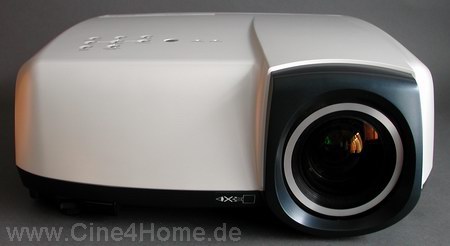
We were all the more surprised, as we actually got the projector in our own hands. the compact dimensions and the solid build quality immediately made a good impression already. About the design can be argued, but the white pearl finish can be well integrated into each home cinema. The black metallic version is not available in Europe unfortunately and remains reserved for the American market only.
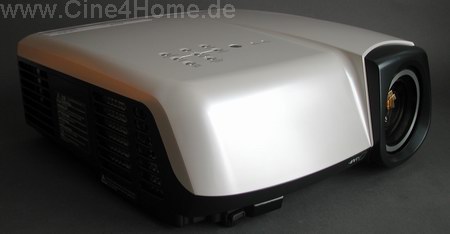
The good impression continues with the placement characteristics: the flexible Lens Shift and the fully motorized optics make placement a children's game. Fascinating is the "volume" of the projector, it is practically missing. It is completely clear that here we have the currently quietest Home Cinema projector on the market. A projector does not have to be more quiet, because even without sound the ventilation does not disturb the ears of the user in the slightest way. It is really impressive how well thought out the ventilation system of the projector is.
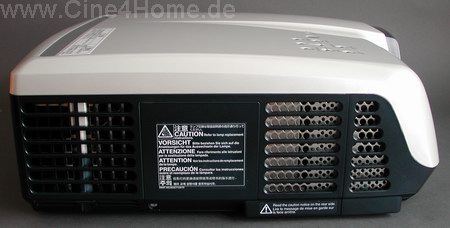
Concerning the operation the system of the other Mitsubishi models was copied. This was a good decision, because it combines many adjustment parameters with good clarity. Nevertheless we saw even better concepts with other manufacturers, so there is a certain potential for improvement. However, no obvious lacks appeared during our testing.
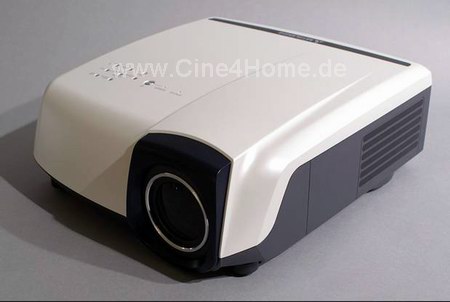
Everything has been said about image quality already, in this price range the HC5000 sets new standards, particularly with regard to image definition and detail representation. LCD artifacts are a thing of the past to a large extent. Only regarding contrast and picture depth there still are superior competing technologies, which does not mean however that the HC5000 is bad in these areas.
All in all, the HC5000 is a successful throw, which offers the buyer an awful lot for his money. We can only recommend a personal demonstration with a specialist dealer in your proximity. But be aware: there is no guarantee that you will not spontaneously leave the shop with € 3990,-- less on your bank account and a cardboard box under your arm! : -)
5. Evaluation
+ Very good build quality
+ Almost inaudibly quiet, also in the rear enterprise quietly
+ Flexible placement with much comfort
+ Clear operation
+ Many options
+ Few LCD artifacts
+ Very good color balance from factory
+ Image Definition
- PAL Film mode with clear weaknesses
- Occasional perceptible functioning of the adaptive iris
- Color Space not perfectly tunable on video standard
- Slight convergence shifts
- Little Horizontal Lens Shift
Evaluation Overall: 1,6 (Good +) |
|
Equipment |
1,4 (Very Good -) |
Operation |
2,0 (Good) |
Technology |
1,6 (Good +) |
Picture |
1,7 (Good +) |
Price/performance |
1,0 (Very Good) |
30. October 2006, Ekkehart Schmitt
Translation: Den Walterfang (november 26th, 2006)
6. Technical Details (according to the manufacturer):
Technology: 3 x 0.74“ LCD (with Micro Lens technology)
Number of pixels \ resolution : 1,920 x 1,080 (total: 2.073.600 pixels)
Picture brightness: 1,000 ANSI lumens
Contrast: 10.000:1 with automatic iris function
Vertical frequency (v-Sync): 50 – 120 Hz
Horizontal frequency (h-Sync): 15 – 100 kHz
Projection Lamp: 160 W
Lamp Life Span: approx.. 5.000 hours (Low mode)
Optics: F/1,8-2,3, f = 24-38 mm
Projection ratio: 1,4-2,3:1
Focus/Zoom: motorized Focus and Zoom (Zoom ratio: 1,6:1)
Picture diagonal: 1,02–7.62 m
Noise level: 19 dB (Low Mode)
PC compatibility: 640 x 480 to 1,920 x 1,080 pixels, Sync on green possible
Video compatibility: NTSC/NTSC 4.43, PAL (inclusive PAL-M, N), PAL-60, SECAM, video comp.: 480 i/p (525 i/p), 576 i/p (625 i/p), 720 p (750 p 50/60 Hz), 1,080 i (1,125 i 50/60 Hz), 1,080 p (1,125 p 50/60 Hz), SCART (RGB+1 V-Sync)
Function/characteristics: Automatic Iris function, motorized Lens Shift function (horizontal and vertical), digital trapezoid correction (horizontal and vertical), 3D Y/C digital Comb filter, 3D Noise Reduction, 3D Color Uniformity Correction, AV Memory function, 10-Bit signal processing, adjustable Gamma function, selectable display formats (WXGA, 720p, XGA, Cinemascope), 10-language OSD, pin code protection (menu adjusments), side access to lamp, safety anchorage
Inputs: PC (RGB): 1 x mini D-Sub 15-polig, 1 x DVI-D (with HDCP)
Video: 1 x HDMI, 1 x RCA, 1 x S-Video, 1 x RCA (Y, PB, PR)
Outputs: 12 V trigger Out, 1 x Stereo mini-jack (ø 3.5 mm)
Communication interfaces: RS-232C, 1 x D-Sub
Remote Control: Complete operation of the projector, background lighting, direct function with AV Memory
Size (B x H x T): 334 x 125 x 352 mm (excl. adjustable feet)
Weight: 5.9 kg
Capacity: 250 W
Power: AC 100–,240 V, 50/60 Hz
Provided accessories: Set of cables, remote control (battery included), safety references (including short operating instructions), multilingual operating instructions (on CD-ROM)
